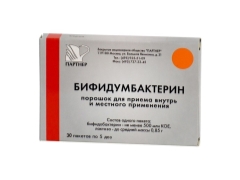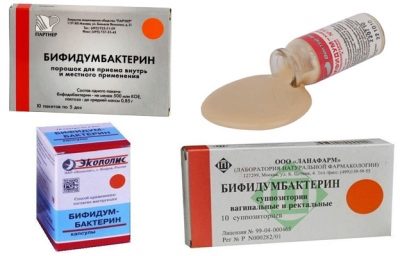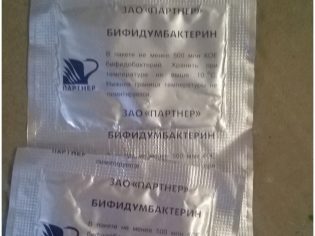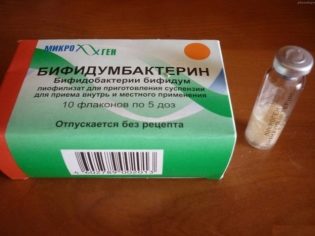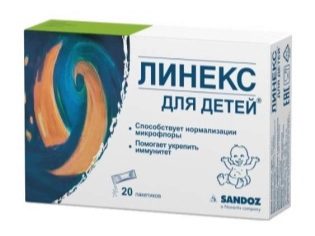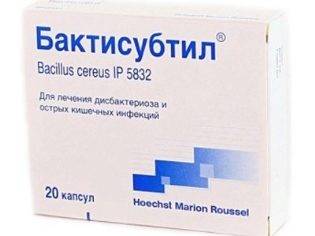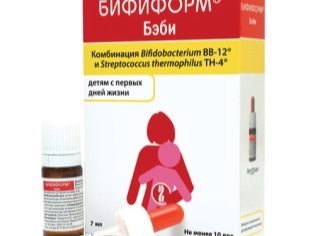Bifidumbacterin for a child
When a child has digestive problems associated with a violation of the composition of the intestinal flora, he is prescribed drugs from the group probiotics. One of the most popular means of this type is Bifidumbacterin. In which cases it is prescribed in childhood, in what form is it used and how is it dispensed?
Release form
Bifidumbacterin is produced in the following forms:
- Lyophilisate. Such Bifidumbacterin can be taken orally after mixing with water or used for external processing. It is represented by a light gray or beige mass. The drug is available in vials packed in a box of 10 pieces. Also there are packs of 12 and 14 bottles.
- Powder. It is sold packaged in bags in packs of 10 or 30 packages. A suspension is prepared from such a powder, which the patient drinks.
- Pills. One pack contains from 20 to 60 tablets.
- Capsules. One jar contains from 10 to 50 capsules.
- Rectal / vaginal suppositories. They are sold for 10 pieces in a pack.
Bifidumbacterin forte is also produced, the difference of which is the presence of activated carbon in the composition, due to which bacteria are evenly released in the intestine, and toxic substances are eliminated more quickly. Such a drug is represented by gelatin capsules and powder, which is taken orally.
Composition
The main ingredient Bifidumbakterin, through which the drug has a therapeutic effect, are the live bacteria Bifidobacterium bifidum or Bifidobacterium longum. A single dose is considered to be at least 10 million CFU of such microorganisms.
In one suppositories contains 1 dose. Capsules are available with 5 doses of bifidobacteria. In one tablet can be 1 dose or 5 doses. One vial of lyophilisate may include 3, 5 or 10 doses. One packet of powder contains 50 million CFUs, which corresponds to 5 doses.
Part dry bifidumbacterin (lyophilisate) In addition to beneficial microorganisms, dry milk, gelatin, sucrose and lactulose may be included. The auxiliary ingredient of the powder form is lactose monohydrate. Candles include such additional components as confectionery fat, solid or liquid paraffin, emulsifier, gelatin and other substances.
Tablet form Bifidumbacterin contains not only a lot of bacteria, but also starch, MCC, lactose and calcium stearate. In capsules, additional substances are gelatin, lactose or lactulose, as well as titanium dioxide and dyes.
Operating principle
The therapeutic effect of Bifidumbacterin is caused by the antagonism of bifidobacteria in relation to opportunistic and pathogenic bacteria. Once in the intestine, microorganisms from Bifidumbacterin begin active reproduction and resist harmful microorganisms. Taking this drug:
- Increases the ratio of normal intestinal microorganisms to pathogenic.
- It has a positive effect on metabolic processes and non-specific resistance to diseases.
- Provides sufficient synthesis of vitamin B9, niacin, vitamin K and biotin.
- Participates in the breakdown of fatty acids, as a result of which the level of cholesterol in the blood decreases.
- Normalizes the time of passage of food through the intestines.
- Activates local immunity.
- It counteracts Helicobacter bacteria, due to which it prolongs remission in case of peptic ulcer.
- Minimizes the side effects of ingested drugs.
For information on how bifidobacteria work, see the program "About the most important":
Indications
Bifidumbacterin claimed:
- For the treatment of dysbiosis caused by gastrointestinal diseases, treatment with antibiotics, allergies and other causes.
- When food toxicoinfection.
- With malabsorption syndrome.
- With rickets, hypotrophy or anemia (as a means of complex treatment).
- For the prevention of dysbiosis, for example, with frequent acute respiratory viral infections and treatment with antimicrobial agents.
- With salmonellosis, rotavirus, shigellosis and other intestinal infections.
- With chronic constipation, vomiting or diarrhea, resulting from prolonged antibiotic therapy.
- After operations on the digestive tract.
- With worms or parasite infection.
- With diarrhea caused by chronic colitis.
Infants such a tool is shown with the early transfer of the infant to artificial feeding. He is also discharged if, after eating, the baby erupts abundantly, suffers from colic, bloating, or delayed stool.
At what age is it allowed to take?
Treatment with Bifidumbacterin can be administered to patients of all age categories. Such a drug, if necessary, give even an infant. At the same time, it is better to use probiotics in the treatment of both babies up to a year old and a two-year-old child or older after consulting a doctor. Bifidumbacterin in candles and capsules is prescribed from 3 years.
Contraindications
Bifidumbacterin for children is not recommended for hypersensitivity to any of the components of the drug.
Side effects
In rare cases, the children's body "responds" to taking Bifidumbacterin with an allergic reaction.
Instructions for use and dosage
- To take Bifidumbakterin inside advise during food intake or in 20-30 minutes prior to it. Infants should be given before feeding.
- Bifidumbacterin in dry form is recommended to be diluted with water at room temperature in a volume of about 30-50 ml or with some fermented milk drink. If the medicine is given to newborns or infants, it is permissible to mix it with the mixture or mother's milk. You can not dilute the powder or lyophilisate with hot water (with a temperature above + 40 ° C). In addition, do not store this medicine in liquid form.
- Tablets and capsules are best taken with non-hot water, but any fermented milk product is also well suited for this purpose. If the child cannot swallow the capsule, its gelatin shell is opened and the powder is mixed with 1-2 spoons of boiled water. The resulting suspension is drunk, without waiting for its dissolution.
- A single dose depends on the reason for prescribing Bifidumbacterin. For prophylactic purposes or for chronic pathologies of the gastrointestinal tract, it can be 1 bag, 1 ampoule or 1 capsule, and for acute bacterial intestinal lesions, the dose per dose can be increased to 5 bottles, tablets, powder bags or capsules.
- The frequency of taking Bifidumbakterin is determined individually. Often, the doctor prescribes a double or triple dose, but it is acceptable to use from 1 to 6 times a day.
- The duration of treatment with Bifidumbacterin is also determined by the reason for its use. For example, in chronic intestinal diseases, medication is given in a course of 10-14 days, in acute infections with diarrhea, from 7 to 10 days
Overdose
Since the drug is unable to accumulate in the body, exceeding the dosage of Bifidumbacterin does not lead to the appearance of negative symptoms.
Interaction with other drugs
- Do not use Bifidumbacterin orally while treating antibiotics, as this will reduce the activity of bifidobacteria.
- The appointment of vitamins of group B will increase the therapeutic effect of Bifidumbacterin.
- The drug in suppositories can be treated with antiviral, antibacterial and immunostimulating agents.
If you are interested to see how live bifidobacteria look like under a microscope, look at this post:
Terms of sale
To buy any of the options Bifidumbakterin in the pharmacy, to present a prescription from a pediatrician is not required. The price of the drug varies from 100 to 450 rubles, depending on its form and the number of doses. For example, the average cost of 20 capsules is 200 rubles, and for 10 bottles of lyophilisate you need to pay about 100 rubles.
Storage conditions and shelf life
It is important to store Bifidumbakterin at temperatures up to + 10 ° С. You can transport the drug at a higher temperature (up to + 20 ° C), but not longer than 10 days. It is permissible to freeze the preparation, except for the encapsulated form (the lower temperature limit for the storage of capsules is + 2 ° C). If the labeling of the packaging is not clear, the packaging itself is damaged or the expiration date (it is 12 or 18 months) has expired, such Bifidumbacterin cannot be used.
Dr. Yevgeny Komarovsky tells us why good bacteria are needed:
Reviews
On the use of Bifidumbacterin in children respond mostly positively. Parents emphasize that the drug quickly normalizes digestive function, helps with constipation, diarrhea, bloating, flatulence and other symptoms of intestinal disorders. Bifidumbacterin is tolerated by children in most cases is good, and the side effects of treatment with such a means, according to the responses of moms, are practically not found.
Analogs
Replacing Bifidobacterin may be another probiotic, for example:
- Linex. As part of these capsules, bifidobacteria are supplemented with enterococci and lactobacilli. Such a drug is often used for the prevention and treatment of dysbiosis. It can be given at any age.
- Baktisubtil. These capsules are a source of beneficial Bacillus cereus microorganisms. They are prescribed for salmonellosis, rotavirus infection and other diseases from 7 years of age.
- Bifiform. In such a medicine, represented by a solution, tablets, powder and capsules, contains not only bifidobacteria, but also lactobacilli, streptococci and enterococci, which belong to the beneficial intestinal microflora. The drug can be used from birth.
- Atsipol. In such a probiotic, produced in the form of capsules, contains lactobacilli and polysaccharides from kefir fungi. The drug is especially needed for dysbacteriosis, rotavirus and enterocolitis. It can be given from 3 months of age.
Surely you will be interested to see the program of Dr. Komarovsky, dedicated to the problem of dysbiosis in children:
